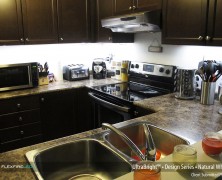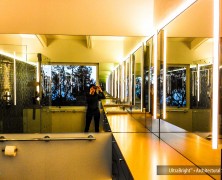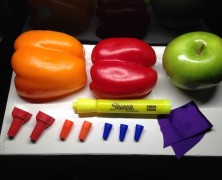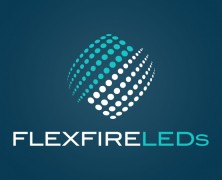Under cabinet lighting is one of the most common applications of LED strip lights. This relatively easy installation is a fantastic addition to any kitchen, office, or work bench area that would benefit from high quality direct task lighting. To illustrate this installation, we’ve put together this step-by-step tutorial on how to install under cabinet LED strip lighting. For this tutorial, we reached out to a customer named Owen in Toronto, Canada. Owen was seeking bright, usable light in his kitchen that could be hard-wired to a standard wall dimmer, and told us he had been, “scouring the web off and on for three years” in search of the perfect solution. In the end, he chose Flexfire LEDs UltraBright LED strip lights in natural white after viewing some of our online installation videos and feeling comfortable with our product quality. It’s important to note that for this installation, Owen enlisted the help of a licensed professional electrician. This is something we recommend for all installations, as it ensures code compliance and avoids potential injuries due to improper handling. Here is a “before” photo of his kitchen, using only the existing overhead lighting. And now, onto the installation! In order to achieve proper brightness and even light distribution, he used our solderless connectors to run two parallel sections of LED strip lights under each of three cabinet sections. In the end, he felt that one single strip would have been more than enough, and this parallel run wasn’t actually necessary. Also, note that the strip lights are very thin and low profile – the strips themselves are only actually visible when viewed from below as photographed here. As Owen says, “The low profile design means I don’t even have to rush to add a valence.”...
Flexfire LEDs Spring 2014 Photo Contest...
posted by Flexfire LEDs
We take pride in helping customers complete all sorts of LED lighting installations. From restaurants and hotels to basic kitchen redesigns, each project has a unique story. For this reason, we are always eager to see photographs of completed projects using Flexfire LEDs strip lights. To this end, we encourage you to participate in the Flexfire LEDs Spring 2014 Photo Contest. Every Entry Wins! We now have two separate contests, and everyone who submits a qualifying entry will win! Our standard photo contest awards prizes in each of three categories, while our new “Step-by-Step Tutorial” contest rewards those who share thorough details of their projects. Furthermore, everyone who sends us a qualifying submission for either contest will receive a coupon for $30 off any reel of Flexfire LEDs strip lights. Below you’ll find details for each of our two contests. Contest 1: Photo Contest Send us a high-resolution photograph of your completed project using Flexfire LEDs products and we’ll reward you with a coupon for $30 off any reel of Flexfire LEDs strip lights. One winner will be selected in each of these three categories: 1. Best Residential Installation (kitchens, bedrooms, bathrooms, basically anywhere in your home) 2. Best Commercial Installation (retail stores, bars/restaurants, offices, signage, etc.) 3. Best Hobby/Creative Installation (past examples include terrariums, Halloween costumes, and a flying wingsuit!) The winning project in each category will receive a FREE reel of Flexfire LEDs ColorBright strip lights. Again, please be sure to send us a high-resolution photograph, as blurred, low-quality images will not be considered. Contest 2: Step-by-Step Tutorial Contest Many of our customers see these great project photos and wonder, “How did they do that?” We’d love to share your step-by-step installation story on our blog. Everyone who submits a qualifying “Step-By-Step Tutorial” entry will receive a...
Why You Should Care About CRI...
posted by Flexfire LEDs
CRI, or Color Rendering Index, is the latest buzzword in consumer lighting circles. With the current phasing out of traditional incandescent bulbs, many consumers are scrambling to understand their remaining choices. Savvy lighting manufacturers understand this, and have invested a great deal in educating customers about things like color temperature, lumens, and now CRI. So how does CRI work? Basically, take a light bulb and shine it onto a few bright, colorful items. How natural do their colors look? Color Rendering Index is a mathematical measure of this, where a light source is tested and given a score from 0-100. Any light bulb, tube, or strip that measures greater than 90 is typically considered “High CRI”, and thus very effective at rendering natural-looking color at a given color temperature. As a point of reference, many of the fluorescent or other types of lighting that people consider “harsh” or “artificial” measure in the 50-70 CRI range. Take a look at the two photos above. In the first photo, under lights rated at CRI 57, the orange bell pepper has lost much of its natural color, appearing almost yellow. Similarly, the green apple, red bell pepper, and yellow marker appear dull and lifeless. In the second photo, under CRI 93 lighting, the colors are much more alive in comparison, down to the white board on which everything is placed. Testing for CRI requires special machinery designed specifically for this purpose. During this test, a lamp is shone onto eight different colors (or “R values”), termed R1 through R8. The lamp receives a score from 0-100 for each color, based on how natural the color is rendered in comparison with how the color looks under a “perfect” or “reference” light source at the same color temperature...
Flexfire LEDs Announces High CRI LED Strip Lights...
posted by Flexfire LEDs
In keeping with its commitment to providing innovative LED lighting solutions, California-based Flexfire LEDs has announced its new UL Listed UltraBright™ High CRI Series LED Strip Lights. Designed to meet today’s higher lighting quality standards, this new line measures >93 on the color rendering index, fortifying the company’s reputation for delivering cutting edge technology at consumer-friendly prices. CRI, or color rendering index, is the standard measure of a luminaire’s ability to accurately render a specific color spectrum in comparison with a perfect reference source at a given color temperature (i.e. daylight). Simply put, if you direct the light onto a particular object, how natural do its colors look? Testing for CRI is a complicated process, requiring specialized machinery designed specifically for this purpose. Lamps are tested in terms of how they render eight basic colors (or “R values”), termed R1 through R8. A score from 0-100 is given for each color, and these eight numbers are then averaged to determine the lamp’s overall CRI rating. Those measuring above 90 are generally considered highly effective at rendering natural color; for a practical understanding, many of the traditional fluorescent lights that people consider “harsh” or “artificial” measure in the 60-70 CRI range. LED lighting is the established industry leader in energy efficiency, and advanced technological development means LED products are now available at dramatically lower prices than even just a few years ago. This dynamic is driving a worldwide shift to LED lighting, one that is further accelerated by government regulations such as those found in California’s Title 24. Established by the State’s Energy Commission, Title 24 addresses a number of energy efficiency standards, particularly those having to do with lighting. To be classified as “High Efficacy” and thus qualify for utility rebates and other advantages,...
LED Signage Lighting
posted by Flexfire LEDs
If your company has a physical office or storefront, chances are you’ve at least looked into commercial signage at some point. If you already have a sign, chances are equally high that you’ve dealt with increased maintenance and energy costs as well as burnt out bulbs and tubes. As many business owners are discovering, these issues are now being addressed thanks to the versatility of LED signage lighting. Because of their tiny size, LED chips can be aligned and configured in a variety of ways to illuminate infinite shapes of indoor and outdoor commercial signage. Flexfire LEDs strip lights, for instance, are perfect for this sort of installation. They are thin, flexible, and come with adhesive backing, meaning they can be applied to follow various angles such as those found in channel lighting. With optional IP weatherproofing, LED strip lights are also resistant to water and dust. It’s important to note that unlike other lighting technologies, LEDs produce direct, precise illumination, a big part of why they’re used in televisions and smartphones. For this reason, LEDs are a perfect backlighting source for letters and company logos in box sign applications as well. Additionally, improved technology means that the initial cost of LED lights has been dramatically reduced over the past few years, removing what has been the main barrier for many business owners. There are four main advantages to using LED lighting for commercial signage as opposed to fluorescent or neon tubes: energy efficiency, durability, safety, and overall light quality. Let’s start by addressing energy efficiency, as it directly affects your company’s bottom line. Energy Efficiency High quality LED and fluorescent signage products are both capable of producing in excess of 100 lumens per watt, meaning they will produce a great deal of light...










